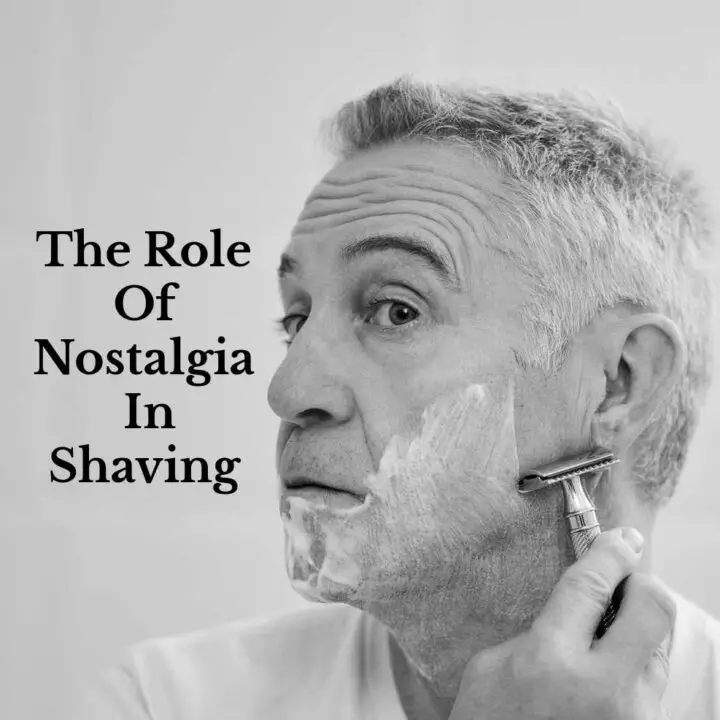
I think most modern wet shaving enthusiasts will agree there is a significant element of nostalgia in the enjoyment of their “hobby.” Whether it’s childhood memories of watching an adult shave, getting an old-school barbershop shave, or just the appeal of a “simpler” time, bringing in elements of nostalgia into the routine can be both pleasurable and calming for any man looking to add some connection to his past into his shave.
I decided to take a deeper look into nostalgia and shaving.
What Is Nostalgia?
Nostalgia is a longing for our past, which is often romanticized. Some people use nostalgia to remember the good times from the past while forgetting the bad, but it can also be mistaken for reality. Nostalgia is different from homesickness and fantasy, because it is mostly a way to remember the past “while wearing rose-colored glasses.”
What Are The Benefits Of Nostalgia?
The benefits of nostalgia include boosting mood, self-esteem, social support, and coping skills. Recent research suggests that nostalgia is a mental health positive, helping us feel connected to the past, inspired to face the present, and like we have a stronger sense of self. Resistance fighters who experience nostalgia are better able to emotionally cope with difficult situations and build strong social bonds with others.
What Are The Downsides To Nostalgia?
Nostalgia can be a risk for some people because it can lead to nostalgia for the wrong things and a loss of focus on the present. If a person is nostalgic for something that never happened or something that is no longer relevant, it can be harmful. To avoid nostalgia risks, people should keep their focus on the present and avoid looking back on happy memories that are no longer applicable or meaningful.
Nostalgia And The Dad Effect
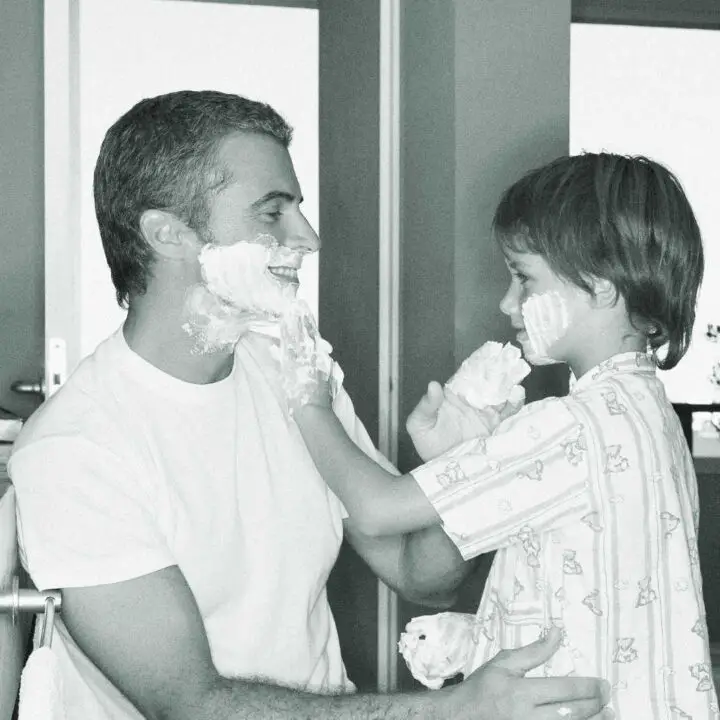
Fathers often factor into nostalgia as they tend to have a special place in our hearts and memories. Fathers can be the source of fond memories, especially during childhood and adolescence. Fathers may also be remembered for providing guidance, protection, and support during difficult times. The presence of a father may also bring a sense of stability to the family unit, providing a sense of security and belonging. So it is not surprising that fathers often factor into nostalgia, evoking feelings of warmth and connection.
The Nostalgia Of Shaving?
I think most of us will agree that there is some kind of element of nostalgia in traditional wet shaving. But how does this element take shape? Is it realistic or romanticized? I decided to dive a little deeper into what historical time frame is most often thought of.
Narrowing Down A Time Frame
A while back I posed a question to Sharpologist’s email information list. I also gathered some data from social media and a couple of the shave forums.
I basically asked two questions: “What is your primary razor type (vintage or modern)?” with two selections, straight razor (or “shavette”) and safety razor (DE, SE, cartridge); and “When You Think Of ‘Nostalgia’ In Shaving, What Time Frame Do You Usually Think Of?” with decades ranging from before 1900 to the present. I asked the two separate questions because I suspected there might be a difference of time frame based on the primary razor type.
About 500 people responded to the poll. And, as I suspected, the results partly depended on what razor they used most often:
Straight razor users most often considered the time frame before 1900 as “nostalgic.” However straight razor users represented less than 10% of the total responses.
Safety razors users most often considered the time frame of the 1950’s as “nostalgic” (by a wide margin). The 1940’s and the 1960’s time frames were mentioned secondarily though. So maybe as a broader range I could say about 1948 to about 1963.
The Nostalgia Of The 1950’s
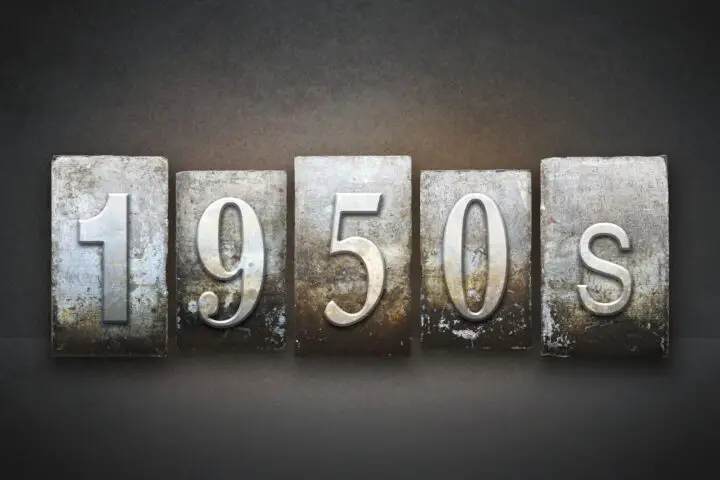
I decided to keep this article a little simpler to research by concentrating on the 1950’s. Some common themes that may evoke nostalgia for the 1950’s include:
- Family life: The 1950’s is often remembered as a time of traditional family values, with a focus on the nuclear family and the suburban lifestyle.
- The post-war boom: The 1950’s followed World War II, and many people remember it as a time of economic prosperity.
- Social and cultural norms: The 1950’s was a time of strict social and cultural norms, and some people may remember it as a more innocent and simpler time.
The 1950’s: An Era of Change
But the 1950’s were also a time filled with change and growth. Technological changes were happening at a rapid rate, and people were becoming increasingly aware of the world outside their own communities. The 1950’s were also a time of great social change with the rise of feminism, the civil rights movement, and rock-and-roll music.
Technology of the 1950’s
The 1950’s were a time of great technological advances that paved the way for future generations. Innovations in mass communication, such as the introduction of television and the marketing of the first commercially produced computer, the UNIVAC, revolutionized how people received and shared information.
The decade also saw the development of new products such as photocopy machines, oral contraceptive pills and long-playing records (LPs). The earliest video game was even invented in 1958!
Scientific discovery was also a major part of the 1950’s with advances in cognitive science, neuroscience and synthetic fuels.
Music of the 1950’s
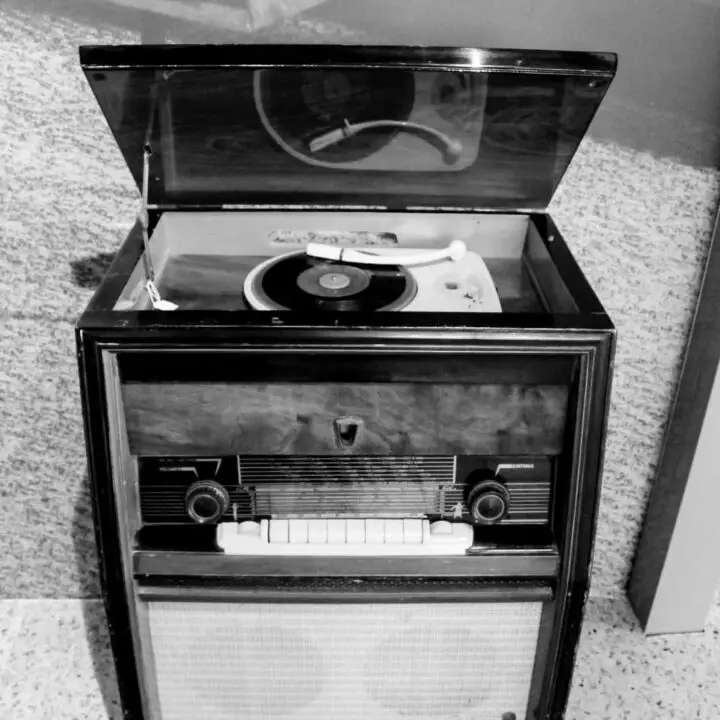
Traditional Pop music of the 1950’s refers to music that was popular before rock music entered the mainstream in the mid-fifties, and also refers to music that became popular at the same time as rock music for the rest of the decade but without the influence of rock.
Some examples of traditional pop artists who were popular during the decade are Perry Como, Tony Bennett, Nat King Cole, Patti Page and Dean Martin. They sang a lot of original material, but many of their biggest hits were either American standards or songs already well known to the public. Most songs in this genre can be classified as simple and Lyrics with catchy melodies.
Many traditional pop artists of the 1950’s were interpreters of pop standards, taking old well-known songs and mixing them with their own personal touches. Some of the most popular interpreters are Ella Fitzgerald, Frank Sinatra, Peggy Lee, and Doris Day. The genre was heavily influenced by swing jazz and big band.
Some songs were instrumentals only. These days many people call this “lounge music.”
Fashion of the 1950’s
The 1950’s was an era of classic and timeless fashion for men. It was a time when men’s clothing was tailored to suit the needs of the modern man. The 1950’s menswear style was all about comfort, elegance, and looking polished. Suits were the outfit of choice for the majority of men in the 1950’s, with trousers, shirts, and outerwear completing the look, often made from luxurious fabrics like wool, rayon, and silk. Men’s trousers were typically made from gabardine, nylon, cotton, linen, flannel, or blends of these materials. The typical 1950’s suit was usually single-breasted with two or three buttons, with cuffed pants and pleated fronts. Accessories such as ties, bow ties, hats, and shoes were also popular. Popular colors included gray, navy blue, brown, and black.
For a more casual look, men often wore Oxford shirts, cardigans, sweaters, polo shirts, and khaki pants or chinos paired with tweed sport coats or navy blazers. Single-breasted jackets were the most popular choice. Double-breasted jackets were also worn but were more reserved for dressier occasions. Accessories were key to any look, with hats, shoes, ties and bow ties all seen as essential elements.
“Wash and wear” fabrics were becoming increasingly popular during this era and made it easier to maintain one’s wardrobe.
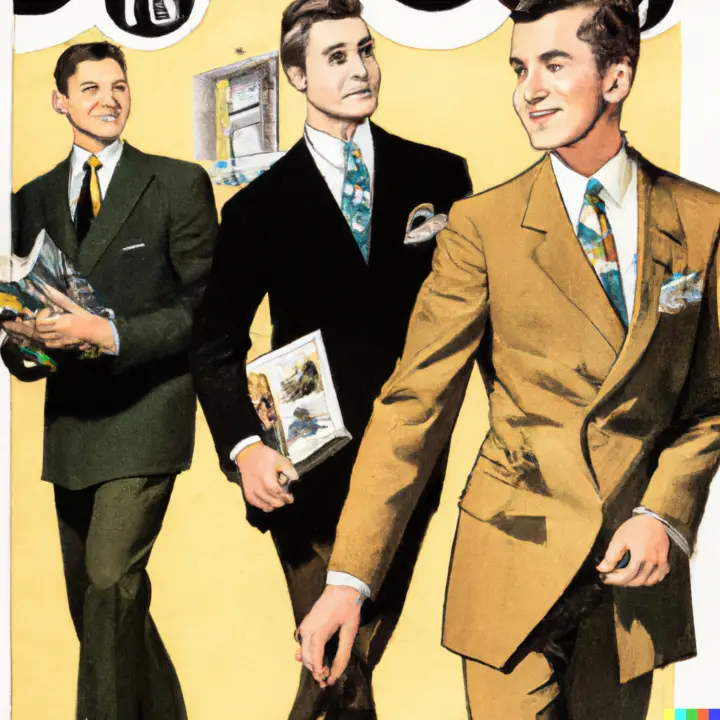
In the 1950’s, men accessorized their look from head to toe. A stylish hat, suit, handkerchief, coordinated tie, socks and shoes were all essential pieces of a man’s wardrobe. Accessories could range from a pocket watch to a cane or walking stick. Belts and suspenders were also popular amongst men and were often used to complete the look. Knit ties were also popular during this time as they offered a more relaxed, yet still fashionable, look. Men embraced bold colors and patterns in their accessories and often matched them with their shirts, ties, and other items of clothing.
Haircuts of the 1950’s
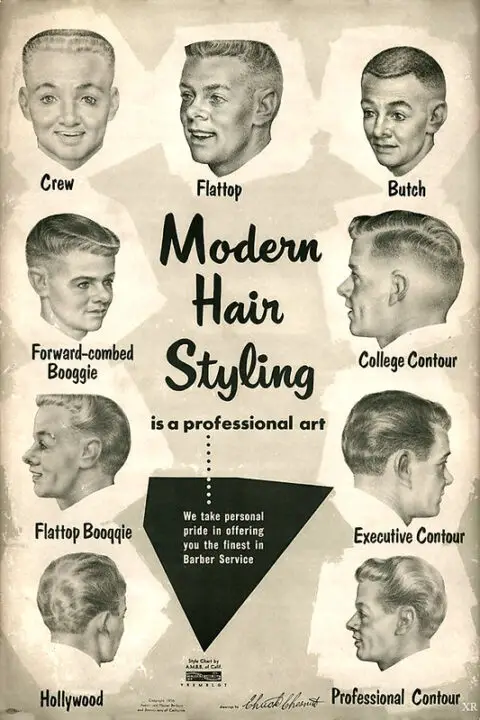
In the 1950’s, the most popular mainstream men’s hairstyles were short and neat, usually maintained with hair tonic or pomade. Popular hairstyles included the slicked back, the executive, the professional contour, and other short, neat styles. Some rebellious youth broke convention with longer and more greased hairstyles like the jelly roll and the Elvis Pompadour.
Men’s Fragrances Of The 1950’s
[Note: Amazon links are affiliate.]
In the 1950s, men’s colognes were a sign of sophistication and style. While the decade was marked by a wide variety of scents, there were a few fragrances that stood out from the rest. Here is a list of the most popular men’s fragrances of the 1950’s (some still available!):
Chanel Pour Monsieur, launched in 1955, is a classic fragrance from Chanel with notes of bergamot, lemon and lavender, this cologne has a refreshing and masculine scent.
Old Spice by Shulton was one of the most popular men’s fragrances of the 1950’s (even though it was first released in the 1930’s). It featured a top note of gardenia and bergamot, and a spicy floral heart. It was a favorite among men of the time and is still popular today (though the scent profile has changed).
Magie by Coty was another popular men’s fragrance. It was released in 1950 and had a falcon that featured an elegant design. It was a popular choice for many men of the time.
Canoe by Dana was a top choice for men. The fragrance featured a light, woody scent. It was a timeless classic that was popular among men of the time.
English Leather by MEM was another popular choice for men in the 1950’s. It had a unique blend of leather and citrus notes that appealed to many men of the time. It was a classic scent that still holds up to this day.
Floris London No. 89 might be considered to be the quintessential scent for the English gentleman in the 1950’s.
Looking Back At The Real Shaving Culture Of The 1950’s
The nostalgia of shaving in the 1950’s is supported by the availability of products and images that bring back memories of simpler times. I reached out to brands like Gillette and Barbasol about shaving products of the 1950’s along with more general research about shaving in the 1950’s.
Shaving: How It Was Done In The 1950’s
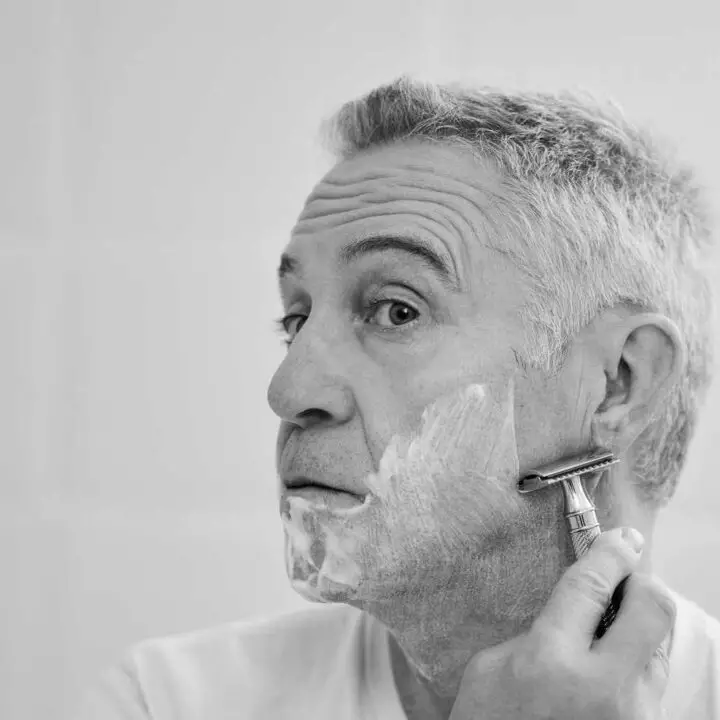
Ultimately, men’s shaving in the 1950’s was just a routine personal hygiene task.
What It Was Like To Shave In The 1950’s?
Typically shaving was performed every day with a single pass and some touch-up. Yes, a “five o’ clock shadow” by day’s end was fairly common and if a man was going out for the evening he would shave again.
There was very little discussion about the “grain” of shaving when I looked at a lot of old razor instruction pamphlets. One British Gillette Aristocrat Rocket (the British version of the Super Speed) razor instruction leaflet did mention a pass with the grain and another pass against the grain, but the great majority of razor instructions suggested simply shaving on the diagonal (a technique I once described as “The Gillette Slide”).
One Schick Injector razor instruction leaflet did mention the shaver could “bare down” on the razor more with an Injector razor due to its different blade guard design.
I think it’s safe to assume that young men in the 1950’s relied less on instructions included with products and more on being coached by their father/grandfather.
What Kinds Of Razors And Blades Were Popular In The 1950’s?
Gillette double edge razors were by far the most popular, with the popularity of improved one-piece, “twist-to-open” (TTO) razors like the premium Executive & Aristocrat, mid-tier Milord, and of course the famous Super Speed (by the way, Gillette began putting date codes back on the razors in 1951).
Gillette 1955’s Light/Medium/Heavy Super Speed TTO razors provided different blade exposures for various beard and hair types. The three different colored handles and matching cases made them stand out in store, but more importantly the variations in the three razors allowed men to get the “right” shave for them. This insight would be further enhanced with the iconic adjustable razors (Bottom Dial, Fat Boy, Toggle, etc) which for some people are the epitome of Gillette in the 1950s.
Blades were also dominated by Gillette with their new blade dispensers and their “Twist – ZIP – Twist” advertising slogan. The twist-to-open razors and new blade dispensers combined to address the long-standing issue of consumers having to handle the sharp blades during loading.
Most blades in the 1950’s were made of carbon steel. Wilkinson’s revolutionary razor blade technology would not take hold until the 1960’s.
Other razors like Schick and GEM were far behind in terms of sales.
What Types Shaving Creams Were Used In The 1950’s?
Counterintuitively to the modern wet shaving enthusiast, the most popular shaving lubricants in the United States of the 1950’s were brushless creams and canned foams.
Gillette Foamy canned shave foam was introduced in 1953, though Gillette also continued to offer a brushless cream and a lathering cream (both in tubes).
At one point, Barbasol was standard issue to the US military in WWII and its popularity continued into the 1950’s in the United States. The introduction of aerosol cans in the 1950s prompted a change in the Barbasol formula in the mid-50’s from a thick cream into a soft, fluffy foam similar to what is currently seen on shelves. The iconic barbershop pole design on the first aerosol cans remains a signature trademark for the brand.
Molle, Colgate, Burma Shave, and Palmolive also had their products in the mass market mix.
Great Britain and Europe were more “civilized” in the 1950’s (when it came to shaving) with classic, traditional lathering creams and soaps still popular.
Aftershave Lotions In The 1950’s
In the 1950s, some of the most popular aftershave products for men in the US included:
Old Spice was introduced in 1937 and quickly became one of the most popular aftershaves for men. It was known for its spicy, masculine scent and was marketed as a product that could make men feel “self-confident, attractive and virile.”
Aqua Velva was another popular aftershave in the 1950s. It was known for its refreshing, cool scent and was often advertised as a way to “wake up your face” after shaving.
Old English was another popular aftershave in the 1950s. It was known for its rich, woodsy scent and was often advertised as a product that could make men feel “refreshed and invigorated.”
English Leather was a popular aftershave in the 1950’s that was known for its masculine, leathery scent. It was often advertised as a product that could help men feel “distinguished and refined.”
Pinaud Clubman also deserves a mention as a classic barbershop product.
How To Bring Nostalgia Into A Man’s Shaving Routine – The Effect Perhaps Without The Accuracy?
So, distilling everything presented here, how can 1950’s nostalgia be integrated into the modern man’s shaving routine?
Realistically, genuine 1950’s-style grooming is not really the romanticized idea that most modern wet shavers think of. In fact, it’s kind of boring.
The nostalgia of shaving is more like a hybrid of a number of different ideas and products.
Here are a number of ways to bring nostalgia into your shave while maintaining the advantages of modern products and techniques.
Use A Vintage Razor (Or A New Razor Based On A Vintage Design)
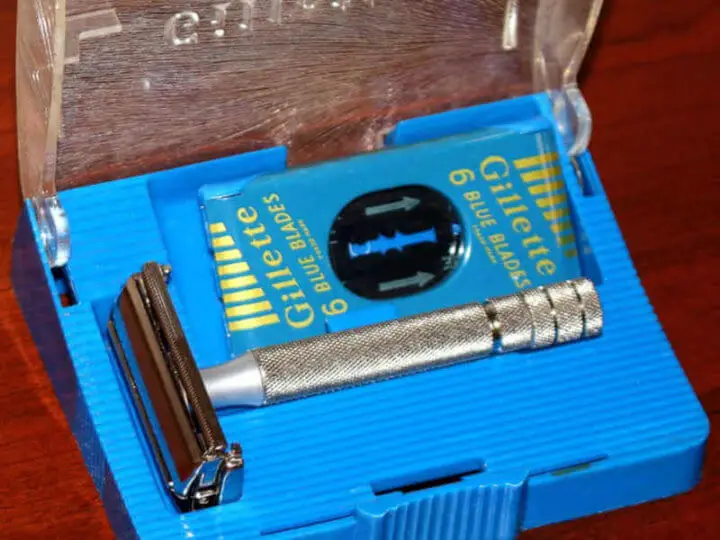
Razors of the 1950’s era were generally quite well-made and many can still be found on internet auction sites, antique stores, and even your grandparent’s bathroom. They can be cleaned up and given a “second life.”
Or you could use a new razor based on a 1950’s design. In that case look for a twist-to-open (sometimes called a “TTO,” “butterfly,” or “silo door”) double edge razor, or an “Injector” style razor. An adjustable version of either of these types of razors would also be something to consider.
Unfortunately the modern razors I have seen that are based on vintage Gillette Super Speed designs are assembled in China or Pakistan and poorly built. They might be acceptable to some but I cannot recommend them.
Some TTO razors I can recommend:
Weishi produced a “knock off” of the Super Speed for years, with spotty quality control. Their newer TTO razors, while not based on the Super Speed, seem to be better built.
Parker produces a number of double edge razors with a TTO design.
The Feather “Popular” double edge razor is inexpensive but has a plastic handle.
The Supply SE razor is a modern take on the Schick Injector razor. From the design aspect it does not look like a Schick Injector of the 1950’s (though some say it does bear a passing resemblance to the PAL Injector razor of the 1960’s). However it is built very well.
If you would still like to use an “old school” razor design without concentrating specifically on the 1950’s there are a number of excellent razors.
Most modern double edge razor blades come individually wrapped. A few double edge razor blades are available in a magazine similar to Gillette’s “Twist – Zip – Twist” package of the 1950’s (like this one from Walgreens) but to use your favorite blade with it you will need to empty the magazine and manually load your own.
Injector style razor blades come in a magazine that generally makes it a “hands off” process.
Use A Shave Brush
Using a shave brush was beginning to be viewed as “old fashioned” in the United States of the 1950’s but modern wet shavers understand and appreciate its benefits. Perhaps consider it more of a nod to nostalgia of the 1930’s.
Use Classic Fragrances
Many personal care products like shave creams of the 1950’s in the US did not have relatively strong, identifiable scents like those found today. Some were essentially scentless, some had a mild “medicinal” scent, and others had a mild “soapy” scent. Secondary scents, if any, were generally citrus (again, very mild).
Consumer-oriented shave products in Europe often had an almond scent (taking its cue from barbershops). Upscale products like shaving soaps from “the three T’s” were generally mild, single note (rose, lavender) items.
Aftershaves are a different story, as described earlier
Modern wet shavers have the luxury of a huge variety of scents from different eras available to them, from homages of scents available in the 1950’s to timeless scents like sandalwoods, citruses, bay rums, etc.
Completing The Nostalgic Shave Environment
Besides actual shaving products, there are some other things you could do to complete your nostalgic shaving experience.
How about hanging some relevant photos on the walls of your “shave den?” These could be old black-and-white photographs of relatives (grandfather shaving?) or some nostalgic pictures of famous people shaving.
According to my un-scientific research about 30% of wet shaving enjoy playing music in the background while they shave. Consider playing “Rat Pack” or “lounge” music to enhance the nostalgic feeling.
Download some nostalgic, jazzy, “Rat Pack” style music to play while you are shaving! 👇
While not strictly about shaving, getting a conservative, short, neat haircut and wearing well-fitting clothes in a style that might be considered “business casual” in today’s world (vs. t-shirt and jeans) would help complete your nostalgic look and feel.
Conclusion: Why We Long For The Days Of Traditional Shaving
Traditional shaving is something that many people try because it takes them back to a simpler time. It’s a way to connect with the past and feel like they’re part of a community. Traditional shaving also allows people to slow down and take their time, which is something that’s sometimes lacking in today’s fast-paced world.

For me at least is a way to reconnect to my late father by doing it in an old fashioned way.
He wasn’t a very approachable person, so certainly peeking in while he was shaving was a no no, but do recall seeing him shave once or twice and even though he used a Gillete Atra II and canned goo, do feel some sort of connection.
With my kids I’m trying to create this bond this time around so they can say that his father did teach them how to shave.
Excellent article. Nostalgia for me was when I rediscovered Pinaud’s Clubman and I took me right back to my grandparent’s house with that scent noticeable in the bathroom. Priceless.
I enjoyed reading this and admire the effort you put into producing it.
Thank you kindly and Happy New Year!
Robby
a vintage DE collector and user
Good article,well done….thank you
To heck with nostalgia. What do I care what shaving process was used 50-60 years ago? I’m for progress – which means what is now is better than what was. I shave for one reason only – to effortlessly remove facial hair as smoothly as possible. What do I care what old grand dad used. I’m sure he was using the best available at the time. Surely both shaving software and hardware have improved in the last half century.
I remember my dad driving a Plymouth with a transmission stick on the steering column and a clutch. Anybody nostalgic for that? Black and white TV? Measles? Polio? Bubonic Plague?
I’m focus on three things: Performance today, performance today and performance today, in that order. Nostalgia is fine as an academic pursuit, not as a way to shave.
Except when the old ways are better for: environment, wallet, shave comfort, adjustability (I sunburned my face, one pass instead of three. Try that with a mach 14 )
Also, if you want to use the latest greatest mostest modernest that’s GREAT!
I believe nostalgia in shaving is important not just for shaving but in reminding us of how daily values are important. I look more to the thirties than the fifties using mainly a Gillette pre-war Tech and New SC to shave. Both of these are durable tools designed for ease of manufacture and use. They were affordable selling with prices roughly equivalent to $10 today. The expectation was men were self-reliant, able to use simple tools without lots of detailed instruction. Daily shaving was necessary to avoid looking like a bum.
Today many of these are lost values. In shaving, we expect the equipment to provide flawless shaves regardless of our skill, whether using the latest five blade vibrating disposable cartridge with multiple rotating axes or the $500-$1000 artisan titanium miracle. We require extensive step-by-step youtube videos to explain how to load a blade, make a lather, shave, apply aftershave, etc. Keeping up our daily appearance is too hard. Our faces are too sensitive to shave daily, so we only shave every second or third day and look like a bum the rest of the time. The other option is to grow a beard which is usually ill-kept and poorly groomed.
So yes, I am nostalgic for the generation of men and their values that built the Empire State Building in a year and a few days. I am not so impressed by the generation that took ten years to build the One World Trade Center.